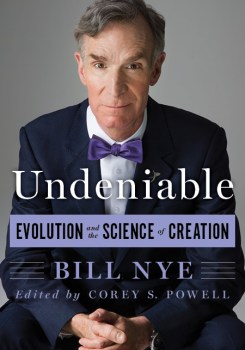Talking Darwin Over Dinner
An excerpt from the Science Guy’s new book, “Undeniable.”
The following is an excerpt from Bill Nye’s book Undeniable: Evolution and the Science of Creation.
While my family was seated together eating a chicken dinner, sometime back in the 1960s, my father described a scene around his family’s table that I like to think of as his version of Darwin’s trip to the Galapagos: the moment when he realized that all living things are related. My grandparents lived in a pretty big house in Washington, D.C. To supplement their income during the Great Depression, my grandmother rented rooms to young men, students, or people just starting out in their careers. One of these guys would often sit at the dinner table and remark offhandedly about the close similarities between a chicken’s knees and our knees, along with other unsettling anatomical parallels.
According to legend, my grandmother was okay with these observations, which carried with it an acceptance of evolution and natural selection. She was quite the naturalist and spent a great deal of time studying wildflowers. But my grandfather, who attended church regularly, was troubled by all this. A link between humans and chickens flew in the face (or beak) of his churchgoing upbringing. The tenant was very nice and paid his rent on time, but his chicken talk was not-so-subtly influencing the kids—my father, his brother, and their friends. These dinners gave my father food for thought for the rest of his life.
My dad returned alive from World War II and went to work as a salesman. Nevertheless, he often referred to himself as Ned Nye, Boy Scientist. My mom spent that war as a lieutenant in the Navy. She was recruited because she was good at math and science; she went on to earn a doctorate in education. So I was brought up with a great deal of respect for the human capacity to figure things out and solve problems. As a kid growing up in Washington, I also had access to the Smithsonian Institution. I was often dumped off… er, I mean, I was often given a ride to the downtown bus and encouraged to visit the museums and see the sights. Like any kid, I was utterly fascinated by the ancient dinosaurs. I thought about how cool it would be to see one of those animals in the wild. Evolution was in my bones, you might say. I was immersed in the scientific story of life on Earth pretty much from the time my own life began. It’s no wonder I ended up writing this book.
Now consider what things were like when Charles Darwin and Alfred Wallace were formulating their ideas in the first half of the nineteenth century. They lived at a time when few people considered the biological meaning of fossil bones. Nobody knew the true age of Earth, and the majority of the ancient creatures we know about today had not yet been discovered. There were no museums full of dinosaur bones; there were probably never any casual dinner conversations about the physiological parallels between humans and chickens. Darwin lived when the ideas that so captivated me as a kid were just beginning to take shape in academic circles.

For many centuries, people in Europe and elsewhere had taken as gospel (perhaps more accurately, from Gospel) that the world had always been pretty much the way it looked right then. But in the late eighteenth century, several thinkers started to question long-held beliefs. The Scottish naturalist James Hutton studied Earth and its natural processes. He is generally regarded as humankind’s first geologist. He reconsidered the idea that Earth has always looked the way it does right now. His writing is hard for me to follow sometimes, as its in florid prose no doubt designed to impress his colleagues, but try this one: “Time, which measures everything in our idea, and is often deficient to our schemes, it to nature endless and as nothing…”
I would rewrite his idea in this way: “Time is part of our thinking in everything we do, and often we seem to have too little of it; in nature, though, there is no limit to the amount of time available…” This insight led Hutton to realize that the landforms he observed were not the product of a creator clocking in for just six days of work and then heading off for a little R & R. Instead, the geology that Hutton observed and documented was clearly the result of countless years of steady change. He rejected the standard story that there had been a great flood, leaving just a few thousand years of history to create everything we see today. Instead, he deduced that there had been slow, continual change of Earth’s surface for eons and eons.
Hutton’s idea is called “uniformitarianism,” and it was one of the crucial insights on which Darwin built his theory of evolution. Uniformitarianism denotes the idea that the world is uniform, or consistent with one set of natural laws; it connotes another idea that the natural laws we deduce today are the same natural laws that applied eons and millennia ago. It’s quite a departure from what Hutton’s contemporaries believed (and what creationists today still do). They believed that a creator could change natural laws to suit her, him, or itself. By necessity, then, natural laws and the natural history of Earth could not be uniform. It was to both Ned Nye Boy Scientist and Bill Nye the Science Guy a completely unreasonable point of view. But, we have the benefit of another century of human thought to influence our reasoning.
From Undeniable by Bill Nye Copyright (c) 2014 by the author and reprinted by permission of St. Martin’s Press, LLC.